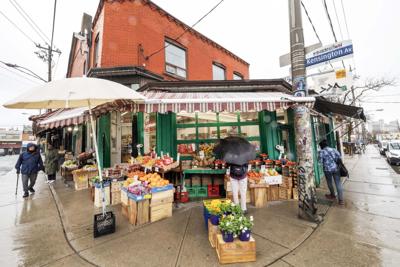It’s taken more than a decade of consultation — and the threat of a Walmart — but Kensington Market may finally be given a special designation next month that aims to preserve the character of the neighbourhood by restricting demolition and new construction.
Next month, city council will be asked to approve designating the downtown neighbourhood a “heritage conservation district,” joining nearly two dozen others in …´…´¿≤.
Kensington has taken so long to get to this point because what makes it special is so difficult to define.
“The city had to really grapple with the cultural elements of Kensington Market,” said Sylvia Lassam, a member of the Kensington Market Historical Society and resident for almost 20 years. “It’s not like Cabbagetown, where what you’re preserving is the buildings. In Kensington Market, you’re trying to preserve something that’s intangible.”
For years, Lassam said, the residents and business owners of Kensington Market have appealed to the city for protection of those intangible virtues against the threat of development.
According to the city, Kensington market is architecturally mixed, a “microcosm of Canada’s diverse immigrant population,” and while most agree it is an important place, there’s no consensus on what makes it so.
¬Ýtypically have architectural styles tied to certain movements or time periods the city wants to maintain, such as the early 20th century “Arts-and-Crafts style” houses of Wychwood Park, or the late 19th century “upper class housing” in Rosedale.
In contrast, “Kensington Market is a state of mind,” Lassam said.
The city’s heritage planning department concluded that the features it wants kept for posterity are the market’s “network of narrow streets and laneways,” its small, mixed commercial and residential buildings, and its local businesses.
“My Kensington Market is probably very different from yours,” said Lassam. “But in terms of what heritage conservation can actually do, they really have done a fabulous job of figuring out what it is about the built form in Kensington Market that’s important and what can be thrown out.”
The Kensington heritage district would comprise 704 properties, satisfy at least some provincial criteria for “cultural heritage value or interest” by being “rare, unique, representative or early example of a style, type, expression, material or construction method.”¬Ý
Demolition of these properties “will not be supported,” the city said in an email to the Star. New construction must be designed in such a way as to retain the area’s “sense of place”¬Ý‚Äî which is a term in the Ontario Heritage Act for characteristics that convey a “common history or set of cultural heritage values.”¬Ý
Practically, this means someone won’t be allowed to “completely obliterate” one of Kensington’s heritage buildings, but they could, say, add a one-storey addition or paint it purple, said Lassam.¬Ý
“It doesn’t imply that this is a museum and that it can’t change,” said Dominique Russell, co-director of the Kensington Market Community Land Trust. “Preserving some of the built form is related to the pedestrian experience, to how it feels to be here.”¬Ý
Russell said¬Ýthe community came together to ask for a heritage community district designation a decade ago in order to oppose a nightmare scenario¬Ý‚Äî a¬Ývertical, commercial market, with all its idiosyncrasies buried under highrises. In 2014, developer RioCan backed away from plans that incuded a 8,800-square-metre Walmart on Bathurst Street, after months of outcry from the community and local politicians.
If it doesn’t pass, said Russell, “there’s the real danger of where it is going to go is kind of a Disneyfied version” of the neighbourhood.
While Russell has long supported heritage conservation status for Kensington, she feels the market has bigger problems ‚Äî chiefly affordability, which her organization tries to help by buying land in the neighbourhood so it can keep prices down.¬Ý ¬Ý
Now the city needs to turn its attention to the fruit markets and grocers¬Ýbeing priced out of the area¬Ý‚Äî businesses “people very much want to hold onto,” said Russell.
“I don’t think the neighbourhood would mobilize for a (heritage conservation district) today,” she added. “The more pressing concerns now are affordability, tenants rights, short-term rentals, the loss of raw food sellers.”
Local councillor Diane Saxe acknowledged that the terms of the Kensington designation are different than a lot of other conservation districts because of the variety of ages and styles of the buildings it contains.
City staff have “gone to a lot of trouble to try to design restrictions that are the least restrictive possible, while preserving those key features,” she said. “I hope it works.”¬Ý



























To join the conversation set a first and last name in your user profile.
Sign in or register for free to join the Conversation